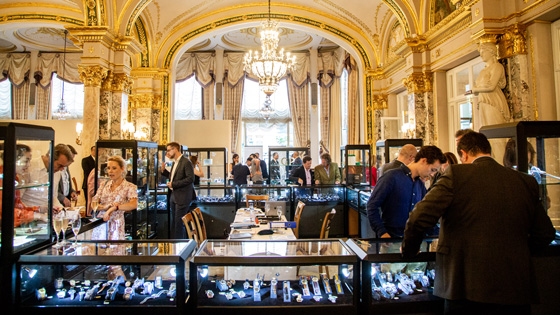
Antiquorum has a longstanding presence in Geneva and Hong Kong and recently opened an office in Monaco.
Specialising in watch auctions, the company has recently diversified into jewellery. The latest news and fundamentals of the trade revealed by Romain Réa.
Auction houses enliven the annual calendar with their spring and autumn sales. Antiquorum is also strongly present throughout the year, organising sales in Geneva, Hong Kong and recently in Monaco. How does such an auction take place? Where do the auctioned pieces come from? How are their prices estimated? Who acquires these timepieces? Romain Réa, watchmaking expert and CEO of Antiquorum since 2017, offers a backstage look at such an organisation.
Gathering timepieces is done by appraisal days organised in different cities around the world, at Antiquorum’s headquarters or in partner boutiques and hotels. These events are generally announced in the press. On site, experts welcome private individuals wishing to dispose of vintage or recent models. Each watch is scrutinized, but the most important criterion that will influence the price is the dial (representing 70% of the estimate). The value of the watch will be significantly higher if the dial is original. All other parts can be repaired or even rebuilt, but not the dial, hence the importance
of its condition.
When assembling the models to be auctioned, there is a definite focus on certain watch brands, such as Rolex, Patek Philippe, Audemars Piguet, Vacheron Constantin and Breguet, which represent the top five when it comes to desirability in this market. They are followed by Omega, Jaeger-LeCoultre, Longines, Universal Genève and Breitling. More generally, watches that have belonged to a personality are also highly sought after by buyers. Recently sold watches include an Omega owned by Elvis Presley (circa 1960), a Vacheron Constantin owned by Evita Peron (1946), a Zenith pocket watch worn by Gandhi (1910) and a Rolex owned by Carlos Coello (circa 1964).
The prices are set in agreement with the seller, with the latter sometimes looking for a higher starting price than the estimate made by Antiquorum and the latter committed to respecting its clients’ wishes. In many instances, the lower the estimate, the better the product sells and sellers are sometimes surprised to find that their watch has been sold for much more than the original price.
When an auction is organised, Antiquorum personally contacts its customers based on their wishes. But who are these clients? Basically, many of them collectors who are looking for timepieces according to a given theme (diving watches, chronographs, etc.), a brand or even a specific collection. Professionals also account for a large part of the customer base, often interested in vintage pieces to expand their range on offer. There is also an ever-growing category of buyers, connoisseurs and investors: people seeking to invest their money in valuable timepieces.
At the end of an auction, around 20% of the lots tend to remain unsold. What happens then? They are simply put up for auction at the next sale with a lower estimate – and usually sold at that second attempt, often exceeding their initial estimate, to the seller’s delight.
The lots at each auction generally include a number of watch brands. However, Antiquorum has sporadically organised single-brand sales, as in 1989, when the Geneva-based house dedicated its first such auction to Patek Philippe. Another such auction was subsequently organised for Vacheron Constantin.
Antiquorum has also developed its online sales, dubbed OLA (Online Live Auction). These proved particularly important during Covid-19, as all live auctions were cancelled, and were indeed a great success.
While the Genevan company focuses on timepieces timepieces, it also offers accessories and has recently branched out into jewellery.
On June 28th at the Hôtel Beau-Rivage in Geneva, Antiquorum resumed its face-to-face sales, as always accompanied by online or phone bidding. This auction was extremely successful, with sales totalling six million francs and more than 83% of lots sold. Rolex was the star of the day with three exceptional lots sold well above their estimates.
Lot 379 was a 1955 Rolex Ref. 6034 Oyster Chronograph in 18-carat pink gold representing an iconic example of the brand’s chronograph production. It was estimated at CHF 250,000-350,000 and sold for 600,000 francs, including fees (CHF 480,000 hammer price).
Lot 346 was an extremely rare Rolex 1680 Submariner Comex model dating from 1979. The marine expertise and maritime engineering company received only about 60 of these timepieces specifically dedicated to it – of which the great majority have since been overhauled, with the Comex dial being replaced by an ordinary Rolex dial. This timepiece, which has never been worn while diving, has remained in incredible condition. In addition, it was sold with its original warranty, another unusual feature. Estimated at CHF 150,000-250000, it went for CHF 524,000 francs including fees (CHF 420,000 hammer price).
Lot 345 was an astonishing Rolex Ref. 1680, Red Submariner, Meter First Mark II with tropical dial, produced in 1969 and sold with its original case and papers. The “Red” Submariner is one of the most sought-after vintage Rolex references. Estimated at CHF 40,000-60,000 francs, it was sold for CHF 103,750 francs including fees (CHF 83,000 hammer price).
The next Antiquorum sale will take place on November 8th and 9th in Geneva.
August 20, 2020


 News
News